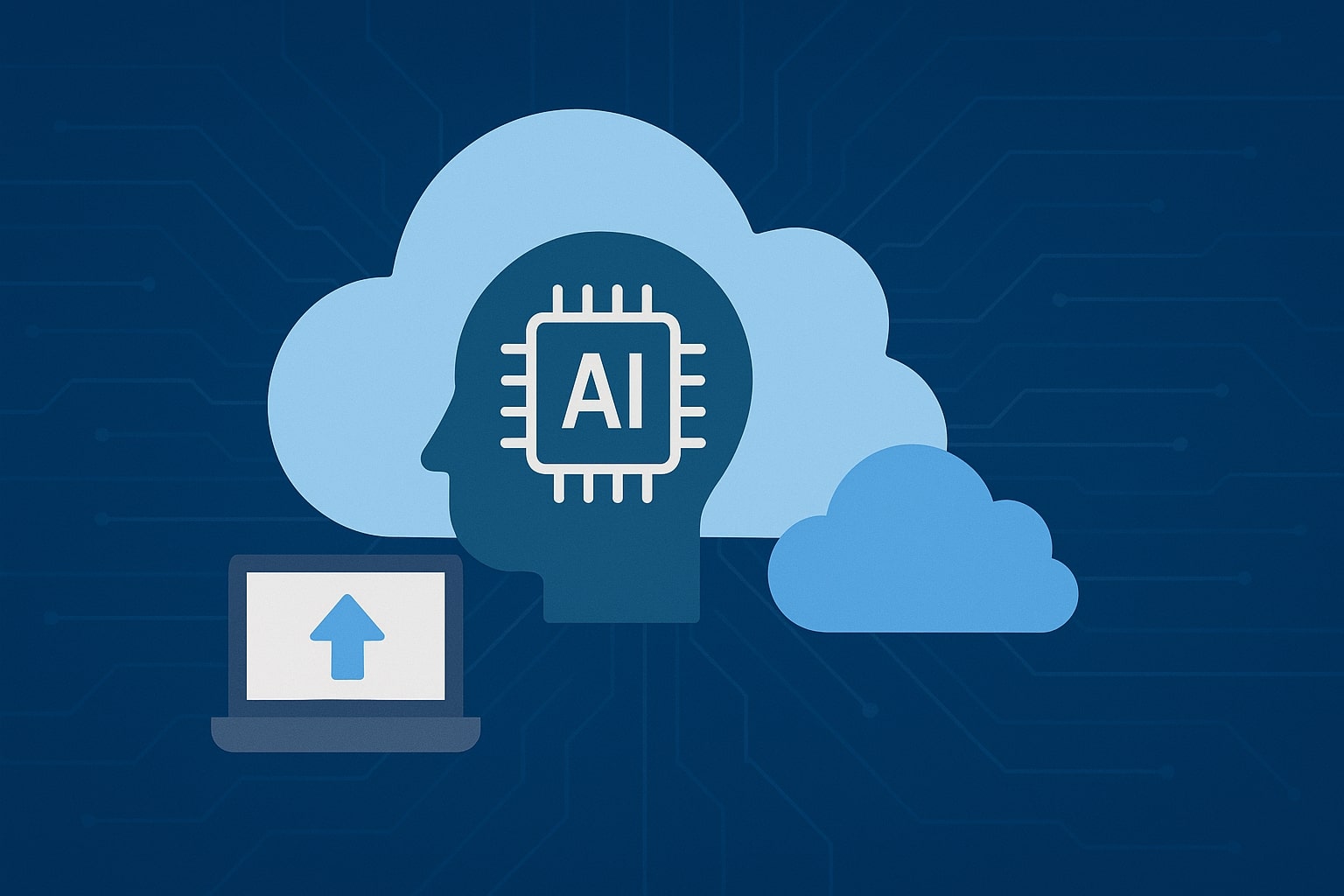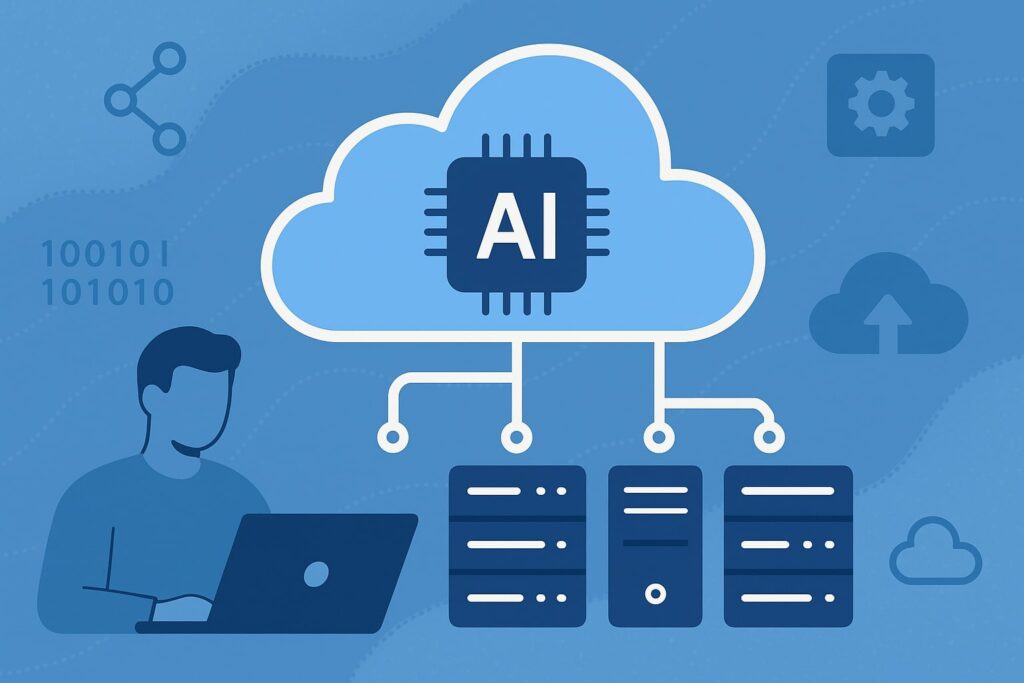
By hostmyai September 29, 2025
Artificial Intelligence (AI) has moved from experimental labs into mainstream business applications. Today, organizations across industries—from healthcare and finance to retail and logistics—are leveraging AI models to streamline operations, enhance customer experiences, and make data-driven decisions.
However, building an AI model is only part of the journey; deploying it efficiently, securely, and at scale is where true business value is unlocked. This is where cloud deployment comes into play.
Deploying AI models in the cloud enables organizations to take advantage of elastic compute power, storage, and managed services, ensuring that AI-powered applications can serve real users in real time.
Cloud platforms also provide infrastructure for monitoring, versioning, scaling, and securing AI models—tasks that can be difficult and costly to manage on-premises.
This guide walks you step by step through the process of deploying AI models in the cloud, covering everything from preparing your model and selecting a cloud provider, to scaling, monitoring, and maintaining production-ready systems.
Whether you are a data scientist, ML engineer, or IT manager, this comprehensive resource will help you bridge the gap between model development and business impact.
Understanding Cloud Deployment for AI Models

Before diving into deployment steps, it’s essential to grasp what cloud deployment means in the context of AI models. Traditionally, organizations trained models locally using powerful on-premises servers or GPUs, then attempted to serve predictions using standalone applications or limited-scale APIs.
However, this approach often proved insufficient when demand grew or when high availability was required. Cloud deployment solves this problem by leveraging globally distributed data centers and managed infrastructure.
At its core, deploying an AI model in the cloud involves hosting the trained model on a serverless or containerized environment and exposing it through an API or application layer so that other systems, applications, or users can interact with it.
A model trained in TensorFlow, PyTorch, or Scikit-learn can be packaged into a Docker container, pushed to a cloud registry, and served using managed services like AWS SageMaker, Google Vertex AI, Azure ML, or Kubernetes clusters.
The benefits of cloud deployment include:
- Scalability: Easily handle thousands or millions of inference requests by auto-scaling resources.
- Cost Efficiency: Pay only for the resources you use, with the ability to scale down during low demand.
- Global Reach: Serve predictions from servers geographically closer to your users, reducing latency.
- Managed Services: Access pre-built tools for monitoring, retraining, and security without building from scratch.
- Collaboration: Cloud platforms support multi-user environments where data scientists, engineers, and business stakeholders can work together seamlessly.
By understanding these fundamentals, organizations can make informed choices about where and how to deploy their models. The cloud not only accelerates deployment timelines but also future-proofs AI investments by ensuring models can evolve and scale alongside business needs.
Step 1: Preparing Your AI Model for Deployment

Preparation is the foundation of a successful deployment. A model that performs well in a research environment may not automatically translate to production readiness. The first step involves cleaning, optimizing, and packaging your AI model for the cloud.
Key activities include:
- Model Optimization
- Pruning and Quantization: Reduce model size and latency without significantly impacting accuracy.
- Conversion for Inference: Convert your training framework model (e.g., PyTorch) into a format better suited for deployment (e.g., TorchScript, TensorFlow Lite, ONNX).
- Pruning and Quantization: Reduce model size and latency without significantly impacting accuracy.
- Dependency Management
- Ensure all libraries, frameworks, and versions required by the model are explicitly documented and included.
- Use virtual environments or containerization to isolate dependencies.
- Ensure all libraries, frameworks, and versions required by the model are explicitly documented and included.
- Testing Locally
- Before deploying to the cloud, test the model on local environments to validate inference speed and accuracy.
- Use representative datasets to simulate real-world input.
- Before deploying to the cloud, test the model on local environments to validate inference speed and accuracy.
- Packaging
- Docker containers are the gold standard for deployment packaging. A container bundles your model, dependencies, and runtime environment into a single unit that can run anywhere.
- Create a Dockerfile that specifies base images, installs required libraries, and defines entry points.
- Docker containers are the gold standard for deployment packaging. A container bundles your model, dependencies, and runtime environment into a single unit that can run anywhere.
- Versioning
- Always version your models. This ensures traceability and makes rollback possible if newer versions underperform.
- Store artifacts in a model registry like MLflow, S3, or Google Artifact Registry.
- Always version your models. This ensures traceability and makes rollback possible if newer versions underperform.
A well-prepared model reduces headaches during deployment. It ensures reproducibility, minimizes compatibility issues, and speeds up the transition from development to production. Think of this step as “packing your bags” before embarking on a trip—you’ll thank yourself later when you’re operating smoothly in the cloud environment.
Step 2: Choosing the Right Cloud Provider and Deployment Strategy

Not all cloud platforms are created equal, and not every deployment strategy fits every use case. The choice of cloud provider and deployment method has long-term implications on cost, performance, security, and scalability.
Cloud Providers for AI Deployment:
- Amazon Web Services (AWS)
- Offers SageMaker for end-to-end ML lifecycle management.
- Provides managed inference endpoints, auto-scaling, and model monitoring.
- Strong ecosystem for enterprises with varied compute and storage needs.
- Offers SageMaker for end-to-end ML lifecycle management.
- Google Cloud Platform (GCP)
- Vertex AI simplifies ML pipelines, model deployment, and monitoring.
- Integration with TensorFlow and TPU hardware accelerators.
- Advanced data analytics and BigQuery integration for ML-driven insights.
- Vertex AI simplifies ML pipelines, model deployment, and monitoring.
- Microsoft Azure
- Azure Machine Learning provides automated ML, deployment endpoints, and governance features.
- Strong enterprise integrations, especially with Microsoft products.
- Azure Machine Learning provides automated ML, deployment endpoints, and governance features.
- Others
- IBM Watson Studio, Oracle Cloud Infrastructure, and smaller providers offer specialized services depending on niche needs or compliance requirements.
Deployment Strategies:
- Serverless Deployment: Ideal for applications with unpredictable workloads. Use AWS Lambda or GCP Cloud Functions to serve lightweight models.
- Containerized Deployment: Run models in Docker containers orchestrated by Kubernetes (EKS, GKE, or AKS). Offers flexibility and control.
- Managed ML Services: Use fully managed offerings like SageMaker or Vertex AI for minimal infrastructure management.
- Hybrid or Multi-Cloud: Some organizations spread workloads across multiple providers for resilience and compliance.
Choosing wisely depends on factors like budget, expected traffic, compliance requirements (e.g., HIPAA or GDPR), and internal expertise. For instance, a startup experimenting with lightweight recommendation models may choose serverless, while a bank handling sensitive customer data may prefer a private cloud or hybrid strategy.
Step 3: Setting Up Infrastructure and Deployment Pipeline
Once your model and provider are ready, the next step is setting up infrastructure to host and serve predictions. This step is about building the “roads” and “bridges” that allow your AI model to interact with real-world applications.
Infrastructure Components:
- Compute Resources: Virtual Machines (VMs), GPUs, or TPUs to handle inference workloads.
- Storage: Secure storage for model artifacts, datasets, and logs (e.g., S3, GCS, Azure Blob).
- Networking: API gateways, load balancers, and private VPCs for secure and efficient communication.
- Security: Identity and Access Management (IAM) policies, encryption, and compliance checks.
Deployment Pipeline (MLOps):
- Continuous Integration (CI): Automate testing and packaging of models.
- Continuous Deployment (CD): Automate deployment to staging and production environments.
- Model Registry: Store and manage multiple versions of models.
- Monitoring Hooks: Collect logs, latency metrics, and error rates in real time.
An example workflow might look like this: a new model is trained → registered in MLflow → packaged in Docker → pushed to Google Artifact Registry → automatically deployed to a Vertex AI endpoint via CI/CD pipeline → monitored with Stackdriver.
By establishing robust pipelines, organizations eliminate manual bottlenecks and human errors. Deployment becomes faster, more reliable, and scalable across multiple environments (dev, test, production).
Step 4: Scaling and Optimizing AI Model Deployment
Once your model is live, the challenge shifts to scaling and optimization. Real-world traffic often fluctuates, and systems must handle both peak loads and quiet periods efficiently.
Scaling Approaches:
- Horizontal Scaling: Add more instances of your service to distribute load. Kubernetes makes this seamless with auto-scaling policies.
- Vertical Scaling: Upgrade the hardware resources (more CPU, GPU, or memory). This is limited by machine specs and costs.
- Edge Deployment: For latency-sensitive use cases, deploy models closer to users at the edge (e.g., AWS Greengrass, GCP Edge TPU).
Optimization Techniques:
- Caching: Store frequent inference results in cache to reduce repeated computation.
- Batching: Group multiple inference requests together to maximize GPU utilization.
- Asynchronous Inference: Handle requests asynchronously to reduce wait times.
- Hardware Acceleration: Use GPUs, TPUs, or FPGAs depending on workload type.
Additionally, cost optimization strategies should not be overlooked. For instance, deploying models in a region closer to users can reduce latency while lowering network egress costs. Similarly, using spot instances for non-critical workloads can dramatically cut cloud bills.
Step 5: Monitoring, Maintenance, and Model Lifecycle Management
Deployment is not the end—it’s the beginning of continuous monitoring and lifecycle management. AI models degrade over time due to concept drift (changes in input data patterns) or data drift (differences between training and live data). Without proper monitoring, accuracy drops and business value erodes.
Monitoring Metrics:
- Technical Metrics: Latency, throughput, error rates, and resource utilization.
- Business Metrics: Conversion rates, customer satisfaction scores, fraud detection accuracy, etc.
- Drift Detection: Tools like Evidently AI can monitor distribution of input data and alert when patterns deviate.
Lifecycle Management:
- Retraining: Schedule periodic retraining using fresh data.
- A/B Testing: Deploy new versions to subsets of traffic to test performance before full rollout.
- Rollback Plans: Always have the ability to revert to previous stable versions.
- Documentation: Maintain logs and audit trails for compliance.
By establishing strong governance, organizations ensure that models remain reliable, ethical, and aligned with evolving goals. Continuous learning pipelines, sometimes called MLOps pipelines, automate retraining and redeployment cycles.
FAQs
Q.1: What are the biggest challenges in deploying AI models to the cloud?
Answer: Deploying AI models to the cloud is not without hurdles. One of the most significant challenges is managing complexity—from handling dependencies across different frameworks to ensuring compatibility with cloud runtime environments.
Another challenge is cost management, as inference workloads running on GPUs or TPUs can quickly inflate bills if not optimized properly.
Security and compliance also remain critical concerns. Organizations in industries like healthcare or finance must adhere to regulations such as HIPAA or GDPR, which require stringent controls on how data and models are handled.
Lastly, monitoring and governance pose challenges because models can drift over time, and without clear oversight, organizations risk making inaccurate predictions that affect business outcomes.
In short, while cloud deployment offers scalability and flexibility, it demands meticulous planning, robust pipelines, and continuous oversight to mitigate risks and maximize ROI.
Q.2: Can small businesses deploy AI models in the cloud, or is it only for large enterprises?
Answer: Absolutely, small businesses can—and increasingly do—deploy AI models in the cloud. Cloud providers have democratized access to sophisticated infrastructure through pay-as-you-go pricing and serverless services, lowering entry barriers.
Small companies can start with lightweight models hosted on AWS Lambda or Google Cloud Functions, paying only for the actual compute time used.
Moreover, cloud providers offer pre-trained AI services (like Google Vision API or AWS Comprehend) that allow small businesses to integrate AI capabilities without building complex models from scratch.
While large enterprises may leverage advanced MLOps pipelines, small businesses can adopt simpler strategies and scale gradually as their needs grow.
This accessibility has leveled the playing field, enabling startups and SMEs to compete with larger players by embedding AI into their products and services with minimal upfront investment.
Q.3: How does cloud deployment compare to on-premises deployment for AI models?
Answer: Cloud deployment and on-premises deployment both have advantages and trade-offs. On-premises deployment gives organizations greater control over infrastructure, which is particularly useful for highly regulated industries or applications requiring strict data residency. It may also reduce recurring costs in cases where infrastructure is already owned and optimized.
On the other hand, cloud deployment offers flexibility, scalability, and speed. Provisioning new resources takes minutes rather than months, and services are available globally.
For organizations with fluctuating workloads, the cloud’s elasticity is invaluable, whereas on-premises systems may remain underutilized during off-peak times.
Ultimately, the decision depends on business needs, budget, and compliance requirements. Many organizations adopt a hybrid approach, keeping sensitive workloads on-premises while leveraging the cloud for less critical or scalable tasks.
Q.4: What tools and frameworks are commonly used for cloud AI deployment?
Answer: A wide range of tools and frameworks support cloud AI deployment. For packaging, Docker and Kubernetes dominate, offering containerization and orchestration capabilities. For model conversion and optimization, ONNX, TensorRT, and TensorFlow Serving are widely used.
In terms of monitoring and lifecycle management, platforms like MLflow, Kubeflow, and Evidently AI provide robust functionality. Managed cloud services like AWS SageMaker, Google Vertex AI, and Azure ML abstract much of the complexity, enabling teams to focus on the business logic rather than infrastructure.
The ecosystem is evolving rapidly, and choosing tools often depends on organizational maturity. Beginners may prefer managed services with built-in monitoring, while advanced teams may build custom pipelines using open-source tools.
Q.5: What are best practices for ensuring cost efficiency when deploying AI models in the cloud?
Answer: Cost efficiency begins with right-sizing resources. Not every model requires a GPU; some can run effectively on CPUs. When GPUs are necessary, consider using spot instances or preemptible VMs for non-critical workloads.
Another best practice is implementing auto-scaling policies to ensure resources scale up during peak demand and scale down during idle times. Caching frequent predictions, batching requests, and optimizing model size through pruning or quantization can also lower compute costs.
Additionally, monitor resource utilization closely using cloud-native tools like AWS CloudWatch or GCP Operations Suite. By regularly reviewing usage patterns and adjusting configurations, organizations can avoid unnecessary expenses and make informed trade-offs between performance and cost.
Conclusion
Deploying AI models in the cloud is the critical step that transforms theoretical potential into real-world impact. From preparing models and choosing the right cloud provider, to setting up infrastructure, scaling, and continuous monitoring, each stage plays a vital role in ensuring success.
While challenges exist—such as cost, security, and governance—the benefits of scalability, flexibility, and speed make cloud deployment the preferred approach for organizations of all sizes.
By following the structured steps outlined in this guide, businesses can confidently deploy AI models that deliver consistent value, adapt to evolving data patterns, and scale with demand. In today’s digital economy, where speed and intelligence drive competitive advantage, cloud deployment is not just an option—it’s a necessity.